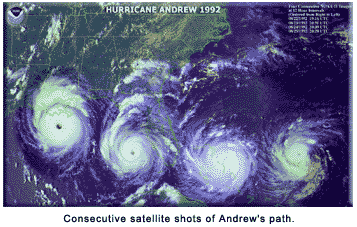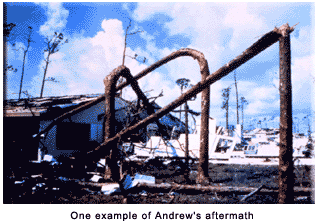Like a beast from the East, Hurricane Andrew opened wide its jaws to engulf Miami, Florida, Homestead Air Force Base, and the remainder of southern Florida during a Category Five¹ fit of fury on August 24, 1992. With sustained winds of 165 mph, Andrew became only the third Category Five hurricane to reach landfall in the United States.
 In terms of intensity,² Andrew became the fourth most intensive storm, at 922 millibars, to hit the U.S. since records have been kept. By contrast, Hurricane Katrina was measued at 918 mbars in 2005; Camille was 909 mbars in 1969, and the granddaddy of storms to make landfall was the Labor Day Hurricane of 1935, at 892 mbars.
Hurricane Gilbert, in 1988, remains the most intense storm ever recorded in the Western Hemisphere, at 888 mbars, thrashing its way through the Gulf of Mexico. Although the eye of Gilbert did not make landfall in the U.S., it nevertheless dumped copious amounts of rain throughout the gulf states and on into Texas and the Midwest, causing severe flooding.
such Category Four and Five storms as Hurricane Andrew develop vortexes — embedded tornadoes — that wreak havoc on life and limb. Andrew generated literally thousands of them, some traceable for several miles, as the monster moved along its fateful path.
Hurricane Andrew also produced a prodigious storm surge of more than 17 feet, with waves as high as 23 feet, at landfall in Florida. Portions of the Louisiana coastline received an eight-foot storm surge as well as a killer tornado, claiming 23 lives in the U.S. and another three in the Bahamas. In addition, Andrew caused damages in excess of $26 billion.
In terms of intensity,² Andrew became the fourth most intensive storm, at 922 millibars, to hit the U.S. since records have been kept. By contrast, Hurricane Katrina was measued at 918 mbars in 2005; Camille was 909 mbars in 1969, and the granddaddy of storms to make landfall was the Labor Day Hurricane of 1935, at 892 mbars.
Hurricane Gilbert, in 1988, remains the most intense storm ever recorded in the Western Hemisphere, at 888 mbars, thrashing its way through the Gulf of Mexico. Although the eye of Gilbert did not make landfall in the U.S., it nevertheless dumped copious amounts of rain throughout the gulf states and on into Texas and the Midwest, causing severe flooding.
such Category Four and Five storms as Hurricane Andrew develop vortexes — embedded tornadoes — that wreak havoc on life and limb. Andrew generated literally thousands of them, some traceable for several miles, as the monster moved along its fateful path.
Hurricane Andrew also produced a prodigious storm surge of more than 17 feet, with waves as high as 23 feet, at landfall in Florida. Portions of the Louisiana coastline received an eight-foot storm surge as well as a killer tornado, claiming 23 lives in the U.S. and another three in the Bahamas. In addition, Andrew caused damages in excess of $26 billion.
 Homestead Air Force Base sustained staggering damages and led to its closing as a full active-duty facility. It has been partially rebuilt and now serves as a U.S. Air Reserve base.
Like all catastophic storms that cause devastation, the name Andrew has been officially retired (1993) and has been replaced with the name Alex.³
Homestead Air Force Base sustained staggering damages and led to its closing as a full active-duty facility. It has been partially rebuilt and now serves as a U.S. Air Reserve base.
Like all catastophic storms that cause devastation, the name Andrew has been officially retired (1993) and has been replaced with the name Alex.³